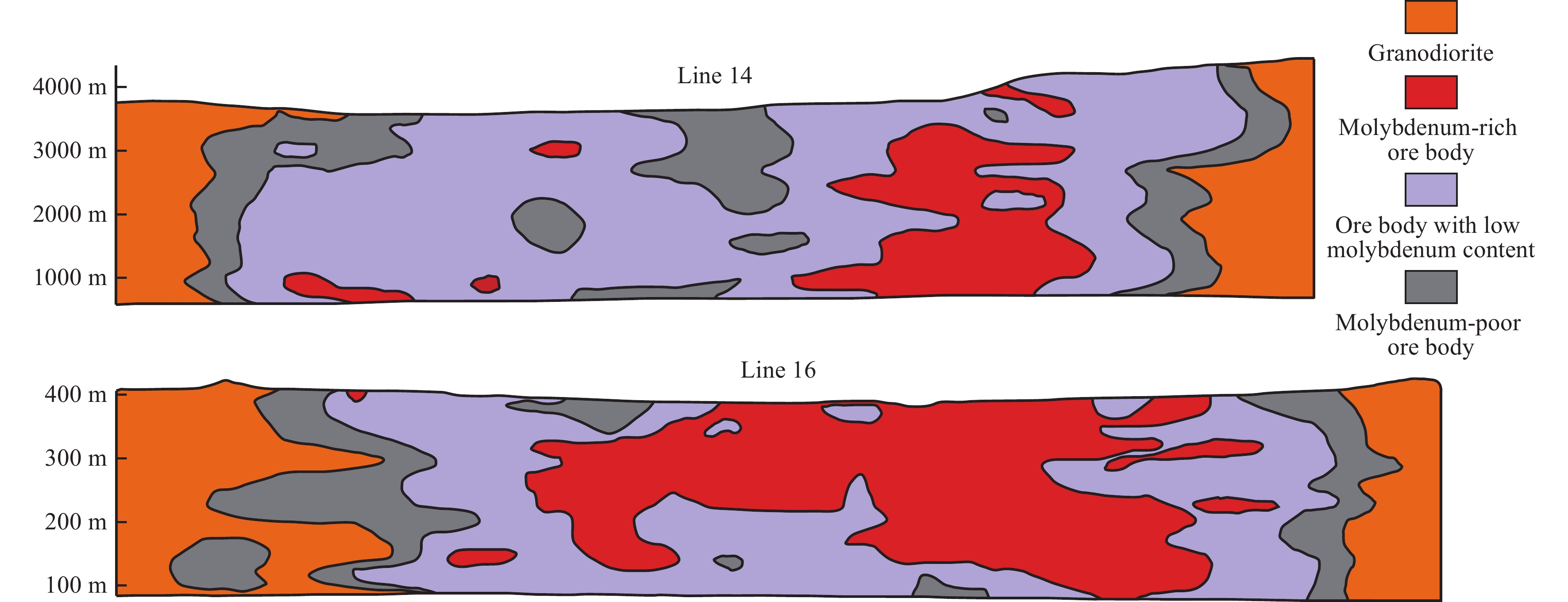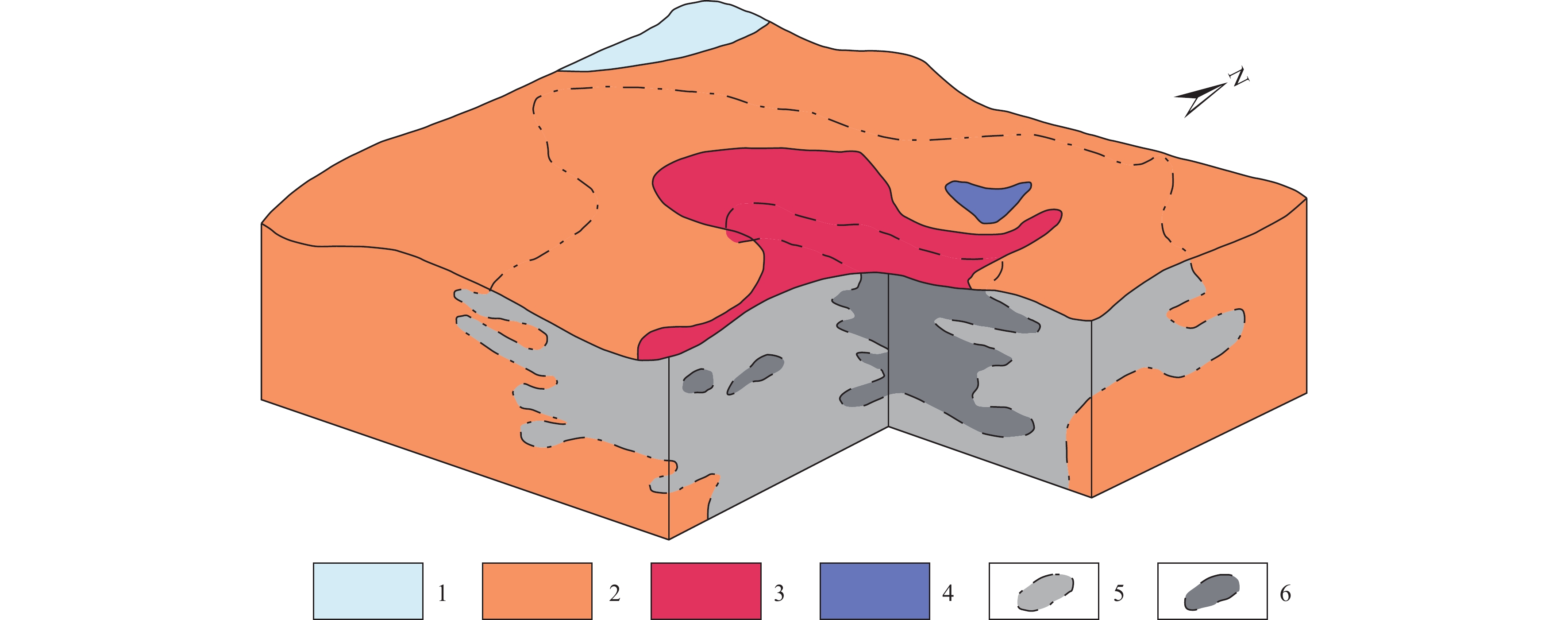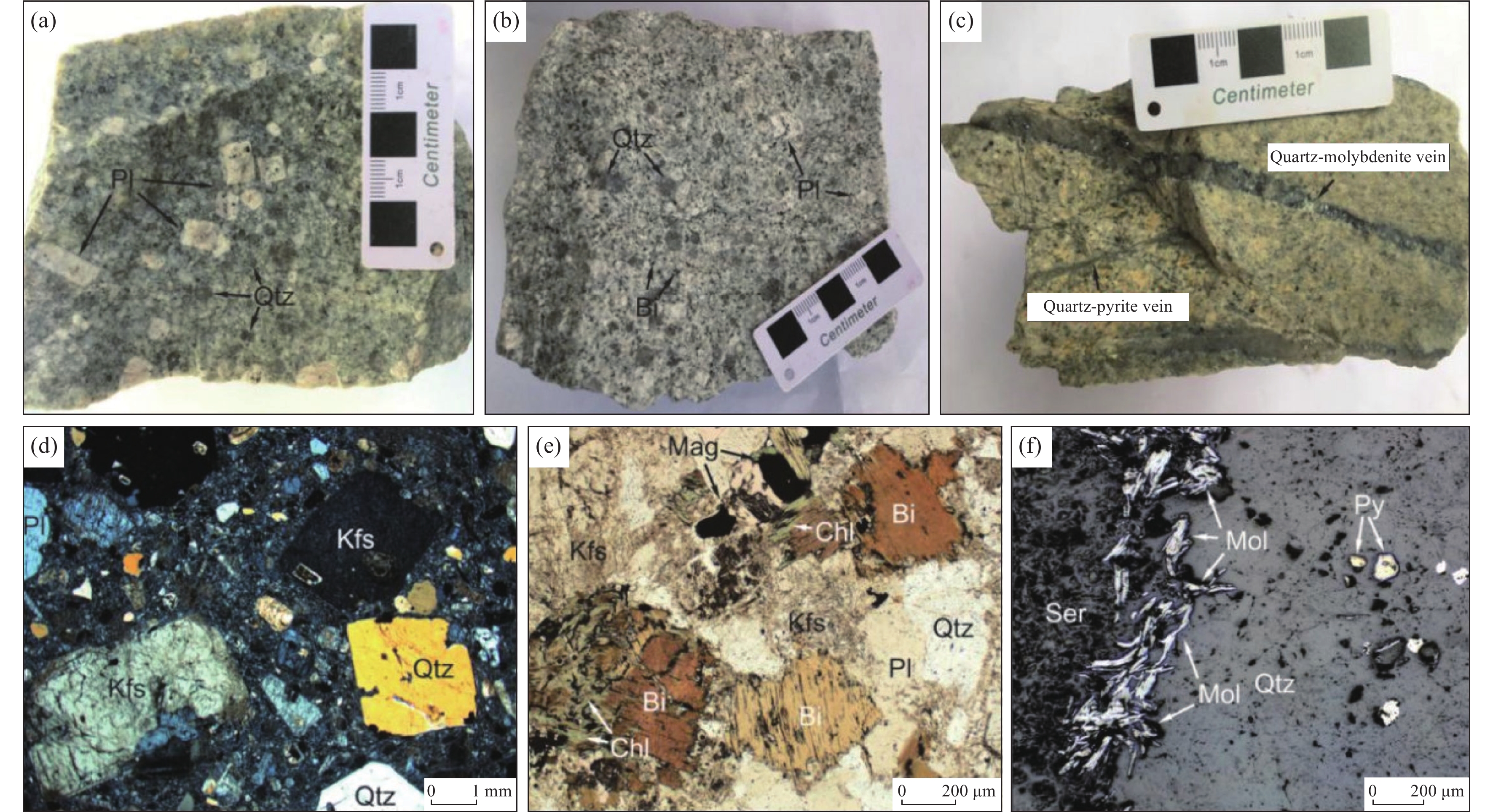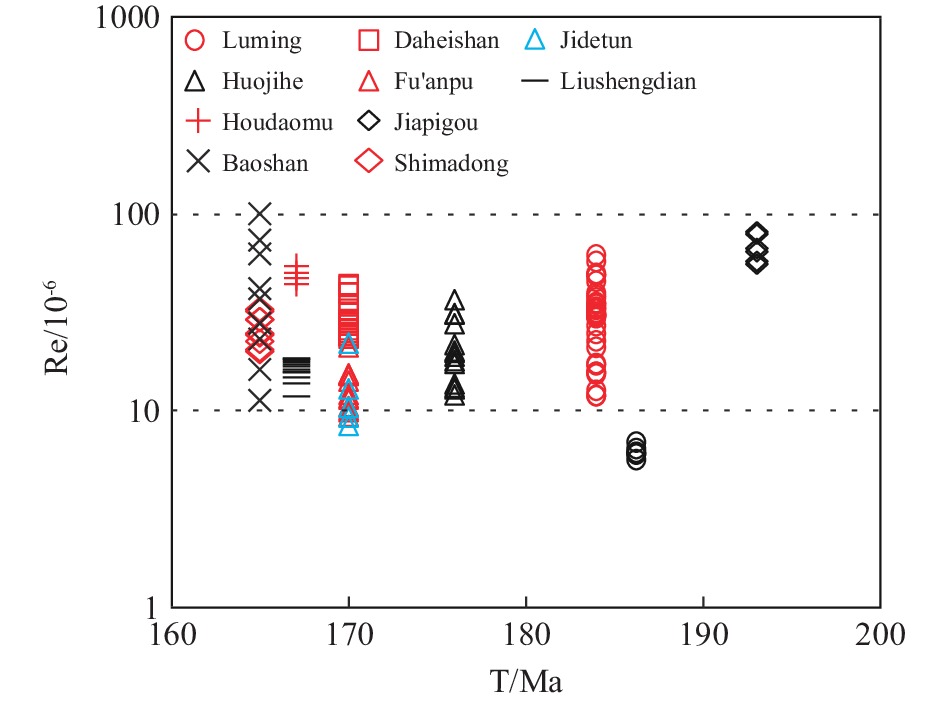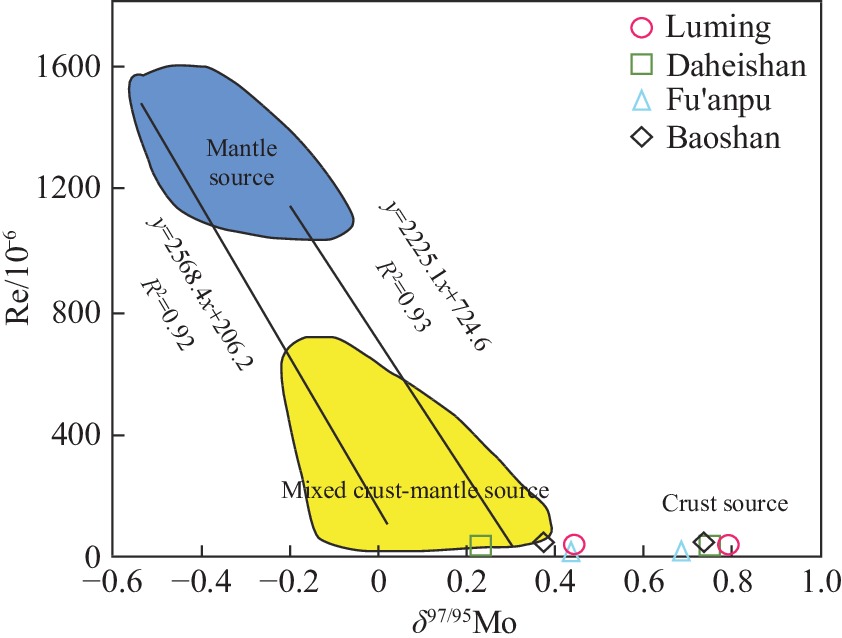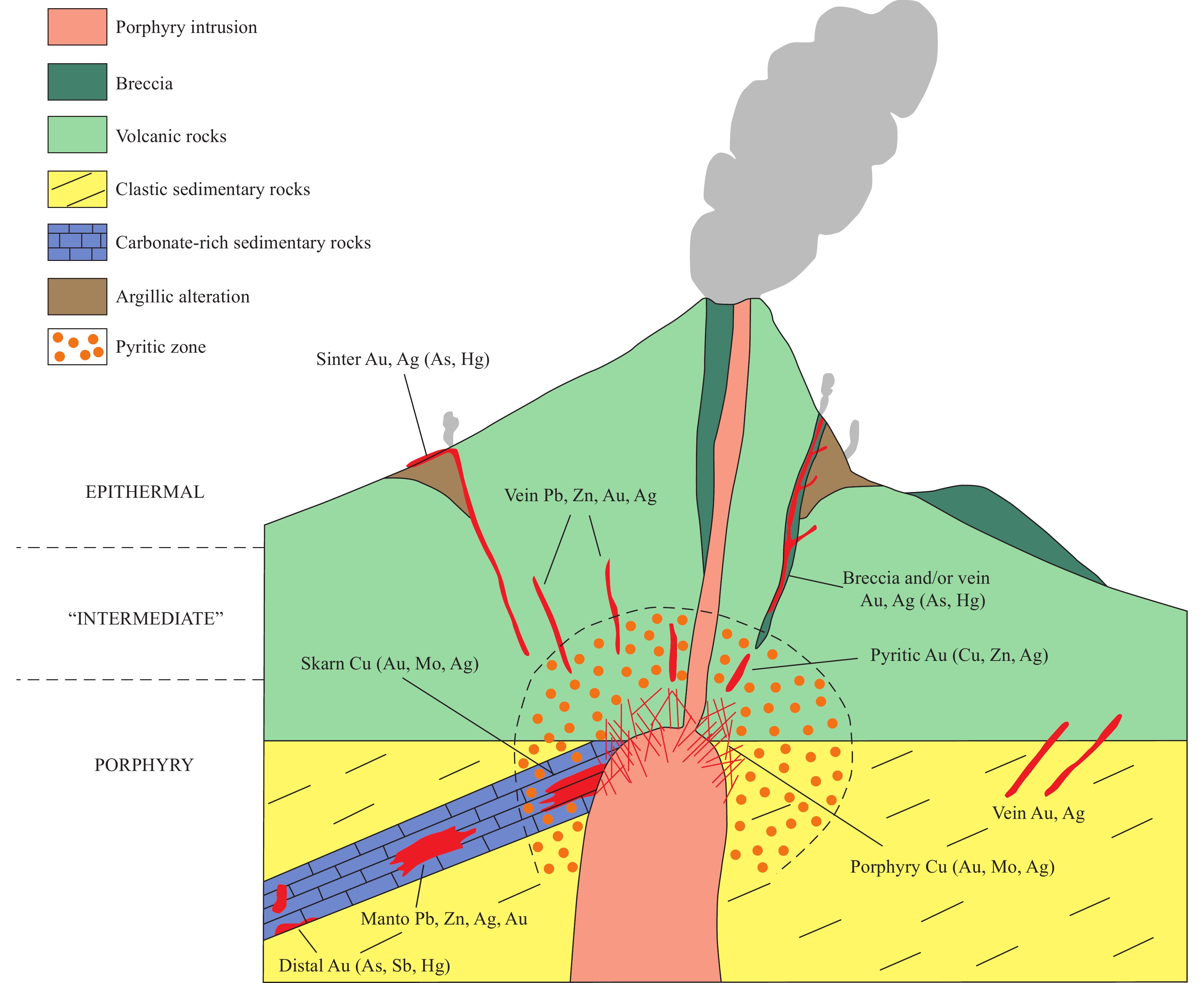| Citation: | Nan Ju, Di Zhang, Guo-bin Zhang, Sen Zhang, Chuan-tao Ren, Yun-sheng Ren, Hui Wang, Yue Wu, Xin Liu, Lu Shi, Rong-rong Guo, Qun Yang, Zhen-ming Sun, Yu-jie Hao, 2023. Geology and mineralization of the Daheishan supergiant porphyry molybdenum deposit (1.65 Bt), Jilin, China: A review, China Geology, 6, 494-530. doi: 10.31035/cg2023039 |
Geology and mineralization of the Daheishan supergiant porphyry molybdenum deposit (1.65 Bt), Jilin, China: A review
-
Abstract
The Daheishan supergiant porphyry molybdenum deposit (also referred to as the Daheishan deposit) is the second largest molybdenum deposit in Asia and ranks fifth among the top seven molybdenum deposits globally with total molybdenum reserves of 1.65 billion tons, an average molybdenum ore grade of 0.081%, and molybdenum resources of 1.09 million tons. The main ore body is housed in the granodiorite porphyry plutons and their surrounding inequigranular granodiorite plutons, with high-grade ores largely located in the ore-bearing granodiorite porphyries in the middle-upper part of the porphyry plutons. Specifically, it appears as an ore pipe with a large upper part and a small lower part, measuring about 1700 m in length and width, extending for about 500 m vertically, and covering an area of 2.3 km2. Mineralogically, the main ore body consists of molybdenite, chalcopyrite, and sphalerite horizontally from its center outward and exhibits molybdenite, azurite, and pyrite vertically from top to bottom. The primary ore minerals include pyrite and molybdenite, and the secondary ore minerals include sphalerite, chalcopyrite, tetrahedrite, and scheelite, with average grades of molybdenum, copper, sulfur, gallium, and rhenium being 0.081%, 0.033%, 1.67%, 0.001%, and 0.0012%, respectively. The ore-forming fluids of the Daheishan deposit originated as the CO2-H2O-NaCl multiphase magmatic fluid system, rich in CO2 and bearing minor amounts of CH4, N2, and H2S, and later mixed with meteoric precipitation. In various mineralization stages, the ore-forming fluids had homogenization temperatures of > 420°C‒400°C, 360°C‒350°C, 340°C‒230°C, 220°C‒210°C, and 180°C‒160°C and salinities of > 41.05%‒9.8% NaCleqv, 38.16%‒4.48% NaCleqv, 35.78%‒4.49% NaCleqv, 7.43% NaCleqv, and 7.8%‒9.5% NaCleqv, respectively. The mineralization of the Daheishan deposit occurred at 186‒167 Ma. The granites closely related to the mineralization include granodiorites (granodiorite porphyries) and monzogranites (monzogranite porphyries), which were mineralized after magmatic evolution (189‒167 Ma). Moreover, these mineralization-related granites exhibit low initial strontium content and high initial neodymium content, indicating that these granites underwent crust-mantle mixing. The Daheishan deposit formed during the Early-Middle Jurassic, during which basaltic magma underplating induced the lower-crust melting, leading to the formation of magma chambers. After the fractional crystallization of magmas, ore-bearing fluids formed. As the temperature and pressure decreased, the ore-bearing fluids boiled drops while ascending, leading to massive unloading of metal elements. Consequently, brecciated and veinlet-disseminated ore bodies formed.
-

-
References
Bi SY, Wang DR, Jia DC, Shao JB. 1995. The basic characteristics of the structure of the terrain in Jilin Province. Jilin Geology, 14(1), 1–14 (in Chinese with English abstract). Cai JH, Yan GH, Xiao CD, Wang GY, Mu BL, Zhang RH. 2004. Nd, Sr, Ph isotopic characteristics of the Mesozuicintrusive rocks in the Taihang-Da Hinggan Mountains Tectonomagmatic Bclt and thcir source region. Acta Petrologica Sinica, 20(5), 1225–1242 (in Chinese with English abstract). Chang C, Sun JG. 2007. Study on metallogenic regularity and minerallizition conditions of the porphyry type polymetallic ore deposit in eastern Jilin province: Taken Xiaoxinancha gold-copper deposit as an example. Journal of Changchun Institute of Technology (Natural Science Edition), 16(25), 56–60 (in Chinese with English abstract). Chen JS, Ge WC, Chen HJ, Xing DH, Liu M, Li WW. 2015. Geochemistry and genesis of the host rock of Daheishan molybdenum deposit in Yongji, Jilin Province. Geology and Resources, 24(2), 93–101 (in Chinese with English abstract). doi: 10.13686/j.cnki.dzyzy.2015.02.003. Chen WM. 1984. Mineral sources and evaluation marks of porphyry copper deposits in China. Journal of Institute of Mineral Deposits, Ministry of Geology and Mineral Resources, 1984(2), 1–78 (in Chinese with English abstract). Chen WM. 2002. On genesis of porphyry copper deposit. Geoscience, 16(1), 1–8 (in Chinese with English abstract). Chen YJ, Ni P, Fan HR, Pirajno F, Lai Y, Su WC, Zhang H. 2007. Diagnostic fluid inclusions of different types hydrothermal gold deposits. Acta Petrologica Sinica, 23(9), 2085–2108 (in Chinese with English abstract). Chen YC. 1991. Prospective evaluation of mineral resources in main metallogenic belt of China, Beijing, Geological Publishing House, 16–46 (in Chinese with English abstract). Chen YC, Zhu YS. 1993. Metallogenic models of ore deposits in China. Beijing, Geological Publishing House, 17–23 (in Chinese with English abstract). Deng PL, Yang XD, Huang Q and Chen YX. 1987. Geophysical field characteristics of Daheishan porphyry molybdenum deposit. Jilin Geology, 24(2), 20–33 (in Chinese with English abstract). Dong SB. 1986. Metamorphism in China and its relation to crustal evolution. Beijing, Geological Publishing House, 1–235 (in Chinese with English abstract). Du AD, Zhao DM, Wang SX, Sun DZ, Liu DY. 2001. Precise Re-Os Dating for Molybdenite by ID-NTIMS with Carius Tube Sample Preparation. Rock and Mineral Analysis, 20(4), 247–252 (in Chinese with English abstract). Gao HM. 1995. Review of research on porphyry copper deposits. Advances in Earth Science, 10(1), 40–46 (in Chinese with English abstract). Ge WC, Wu FY, Zhou CY, Zhang JH. 2007. Metallogenic age and geodynamic significance of porphyry Cu and Mo deposits in eastern Xing-Mongolia orogenic Belt. Chinese Science Bulletin, 52(20), 2407–2416 (in Chinese with English abstract). doi: 10.1360/csb2007-52-20-2407. Ge WC, Wu FY, Zhou CY, Rahman A. 2005. The age of the Tahe granitic body in the northern Greater Khingan Mountains and its restriction on the tectonic attribution of the Erguna Block. Chinese Science Bulletin, 50(12), 1239–1247 (in Chinese with English abstract). doi: 10.1360/csb2005-50-12-1239. Ge XH. 1990. Geotectonic environment and evolutionary profile of eastern Jilin Province. Geoscience, 4(1), 107–1131 (in Chinese with English abstract). Han CM, Xiao WJ, Windley BF, Zhao GC, Su BX, Ao SJ, Zhang JE, Zhang ZY, Wan B, Cui B, Qu WJ, Du AD. 2014. Re-Os Age of Molybdenite from the Daheishan Mo Deposit in the Eastern Central Asian Orogenic Belt, NE China. Resource Geology, 64(4), 379–386. doi: 10.1111/rge.12047. Han YW, Ma ZD. 2003. Geochemistry. Beijing, Geological Publishing (in Chinese with English abstract). Hou ZQ, QuXM, Wang SX, Gao YF, Du AD, Huang W. 2003. Re-os age of molybdenite deposits in Gangdite porphyry copper belt, Xizang Plateau: Metallogenic duration and application of kinetic background. Science in China(Series D), 33(7), 609–6181 (in Chinese with English abstract). Hou XG. 2017. Mesozoic metallogenetic granitoids from porphyry Mo deposit in the eastern Jilin-Heilongjiang provinces: Petrogenesis and Molybdenum mineralization. Changchun, Jilin University, Ph. D thesis, 6–155 (in Chinese with English abstract). Hu SX. 1988. Geology and mineralization of North and South China paleo-plate convergence belt. Nanjing, Nanjing University (in Chinese with English abstract). Ji KJ, Wu XH, Zhang GB. 2011. Mineral source, water source, hydrothermal and mineral deposit distribution law. Beijing, Beijing Science and Technology (in Chinese with English abstract). Jiang PM. 1989. Fundamentals of geothermodynamics. Beijing, Science (in Chinese with English abstract). Ju N, Ren YS, Wang C, Wang H, Zhao HL, Qu WJ. 2012. Ore genesis and molybdenite Re-Os dating of Dashihe molybdenum deposit in Dunhua, Jilin. World Geology, 31(01), 68–76 (in Chinese with English abstract). doi: 10.3969/j.issn.1004-5589.2012.01.008. Ju N. 2020. Metallogenic regularity and prospective prediction of porphyry molybdenum deposits in central Jilin Province, NE China. Changchun, Jilin University, Ph. D thesis, 1–117 (in Chinese with English abstract). Li CY, Tang YQ. 1983. Paleoasian Plate Division and Related Problems. Acta Geologica Sinica, 57(1), 1–9 (in Chinese with English abstract). Li JA, Cai HY, Wang JY. 1984. Porphyry Copper Mine in China. Beijing, Science Press, 1–150 (in Chinese with English abstract). Li JH, Xia DX. 1978. Handbook of Isotopic Age Calculation. Beijing, Atomic Energy (in Chinese with English abstract). Li LX, Song WY, Wang DH, Wang CH, Qu WJ, Wang ZG, Bi SY, Yu C. 2009. Re-Os Isotopic Dating of Molybdenite from the Fu′anpu Molybdenum Deposit of Jilin Province and Discussion on Its Metallogenesis. Rock and Mineral Analysis, 28(3), 283–287 (in Chinese with English abstract). Li N. 1993. High Temperature Gas Magmatic Diagenesis and Geoliquid Mineralization. Journal of Institute of Mineral Deposits, Chinese Academy of Geological Sciences, (1), 28–51 (in Chinese with English abstract). Li T. 1963. Average Chemical Composition of Magmatic Rocks in China. Acta Geologica Sinica, 43(3), 271–280 (in Chinese with English abstract). Liu B. 2001. Density and Isochoric Formulae for NaCl-H2O Inclusions with Medium and High Salinity and Their Applications. Geological Review, 47(6), 617–622 (in Chinese with English abstract). Liu B, Guan GX. 1987. Density Formulas and Isovolumetric Formulas of Na Cl-H2O Solution Inclusions and Their Applications. Acta Mineralogica Sinica, 7(4), 345–352 (in Chinese with English abstract). Liu B, Shen K. 1999. Fluid Inclusion Thermomechanics. Beijing, Geological Publishing House, 1–2900 (in Chinese with English abstract). Lu HZ. 1990. Geochemistry of Inclusions. Beijing, Geological Publishing House, 1–242 (in Chinese with English abstract). Lu HZ, Chi GX, Wang ZG. 1995. Genesis and Tectonic Environment of Typical Metal Deposits. Beijing, Geological Publishing (in Chinese with English abstract). Lu HZ, Fan HR, Ni P, Ou GX, Shen K, Zhang WH. 2004. Fluid Inclusion. Beijing, Science Press, 1–444 (in Chinese with English abstract). Lu JM, Chen GP, Ding W. 2007. Construction of 3D ore body model of Daheishan Molybdenum Mine. Mining Engineering, 5(3), 68–70 (in Chinese with English abstract). Lu ZQ. 2017. Geology, Geochemistry and Genesis of Daheishan Molybdenum Deposit in the Central Jilin Province. Changchun, Jilin University, Ph. D thesis, 5–75 (in Chinese with English abstract). Luo MJ, Zhang FM, Dong QY. 1991. Molybdenum deposit in China. Henan Province, Henan Science and Technology Press, 536–538 (in Chinese with English abstract). Ma HW. 1990. Granitoids and mineralization in Yulong porphyry copper belt, Xizang Province. Wuhan, China University of Geosciences Press (in Chinese with English abstract). Mao JW, Zhang ZC, Zhang ZH, Du AD. 1999. Re-Os isotopic dating of molybdenites in the Xiaoliugou W (Mo) deposit in the northern Qilian mountains and its geological significance. Geochimica et Cosmochimica Acta, 63(11–12), 1815–1818. doi: 10.1111/1755-6724.12378-42. Pei RF. 1995. Mineral deposit model in China. Beijing, Geological Publishing House, 39–42 (in Chinese with English abstract). Qu XM, Hou ZQ and Li YG. 2004. Melt components derived from a subducted slab in late orogenic ore-bearing porphyries in the Gangdese copper belt, southern Xizang plateau. Lithos, 74(3–4), 131–148. Rui ZY, Huang CK, Qi GM, Xu J, Zhang MT. 1984. Porphyry Copper (Molybdenum) Deposits in China. Beijing, Geological Publishing House, 1–350 (in Chinese with English abstract). Rui ZY, Zhang LS, Chen ZY, Wang LS, Liu YL, Wang YT. 2004. Discussion on source rock or source area of porphyry copper deposit. Acta petrologica Sinica, 20(2), 229–238 (in Chinese with English abstract). doi: CNKI:SUN:YSXB.0.2004–02–004. Shan WL, Zong HL. 1991. Theoretical method and practice of structural deformation analysis. Beijing, China University of Geosciences Press (in Chinese with English abstract). Shao JL. 1990. Mineralogy of gold prospecting. Beijing, China University of Geosciences Press, 1–158 (in Chinese with English abstract). Shi ZY, Zhou ZH, Wang YZ, Meng GC, Yang ZG, Yu HW, Li C. 2008. Application effect of prospecting geochemical method in discovery process of large and medium-sized molybdenum deposits in central Jilin Province. Jilin Geology, 27(2), 90–96 (in Chinese with English abstract). Sun FY, Jin W, Li BL. 2000. Consideration on metallogenic depth of vein hydrothermal gold deposit. Journal of Changchun University of Science and Technology, 30, 27–30 (in Chinese with English abstract). Sun SS, McDonough WF. 1989. Chemical and isotopic systematics of oceanic basalts: implications for mantle composition and processes. London, Geological Society Special Publications, 313–345. Sun WD, Zhang H, Ling MX, Ding X, Chung SL, Zhou JB, Yang XY, Fan WM. 2011. The genetic association of adakites and Cu-Au ore deposits. International Geology Review, 53(5–6), 691–703. doi:10.1080/00206814.2010.507362. Tang KD, Ju N, Zhang DQ, Zhang GB, Feng Y, Kong JG. 2022. Implication of the tectonic evolution of paleo-asian ocean. Geology and Resources, 31(3), 246–258, 330 (in Chinese with English abstract). Tang RL, Luo HS. 1995. Geology of Yulong porphyry copper (molybdenum) ore belt in Xizang Province. Beijing, Geological Publishing House (in Chinese with English abstract). Tu GZ. 1988. Geochemistry of stratified deposits in China. Beijing, Science Press (in Chinese with English abstract). Wang CH, Song YY, Wang DH, Li LX, Yu C, Wang ZG, Qu WJ, Du AD, Ying LJ. 2009. Rhenium-osmium isotopic dating of molybdenite and its geological significance in Daheishan superlarge molybdenum deposit, Jilin Province. Rock and Mineral Analysis, 28(3), 269–273 (in Chinese with English abstract). Wang L. 2012. Study on the Geological Features and Metallogenic Model of Daheishan Molybdenum Deposit, Jilin Province. Changchun, Jilin University, Ph. D thesis, 6–75 (in Chinese with English abstract). Wang Q, McDermott F, Xu JF, Bellon H, Zhu YT. 2005. Cenozoic K-rich adakitic volcanic rocks in the Hohxil area, northern Xizang: lower-crustal melting in an intracontinental setting. Geology, 33(6), 465–468. doi: 10.1130/G21522.1. Wang Q, Wyman DA, Xu JF, Jian P, Zhao ZH, Li CF, Xu W, Ma JL, He B. 2007. Early Cretaceous adakitic granites in the Northern Dabie Complex, central China: Implications for partial melting and delamination of thickened lower crust. Geochimica Et Cosmochimica Acta, 71(10), 2609–2636. doi: 10.1016/j.gca.2007.03.008. Wang YD, Zhai YY, Lu ZL. 1986. Geological research report of Daheishan Molybdenum Deposit in Yongji County, Jilin Province.1–234 (in Chinese with English abstract). Wang ZG, Niu JH, Zhu WF. 2011. Ore-forming fluid characteristics and metallogenic mechanism of Antuhaigou gold deposit in Jilin Province. World Geology, 30(3), 313–322 (in Chinese with English abstract). Wang ZG. 2012. Study on metallogenesis of Mesozoic endogenetic metal deposits in the eastern part of Jilin province. Changchun, Jilin University, Ph. D thesis, 5–175 (in Chinese with English abstract). Wei JY, Wang GY. 1987. Isotope Geochemistry. Beijing, Geological Publishing House (in Chinese with English abstract). Wu G, Sun FY, Zhao CS, Li ZT, Zhao AL, Pang QB, Li GY. 2005. Discovery of post-Early Paleozoic collisional granites in the northern margin of the Erguna Block and its geological significance. Chinese Science Bulletin, 50(20), 2278–2288 (in Chinese with English abstract). doi: 10.1360/972004-679. Wu FY, Jahn BM, Wilde S, Sun DY. 2000. Phanerozoic crustal growth: U-Pb and Sr-Nd isotopic evidence from the granites in northeastern China. Tectonophysics, 328(1–2), 89–113. doi: 10.1016/S0040-1951(00)00179-7. Wu FY, Sun DY, Ge WC, Zhang YB, Grant ML, Wilde SA, Jahn BM. 2011. Geochronology of the Phanerozoic granitoids in northeastern China. Journal of Asian Earth Sciences, 41(1), 1–30. doi: 10.1016/j.jseaes.2010.11.014. Wu FY, Yang JH, Lo CH, Wilde SA, Sun DY, Jahn BM. 2007. The Heilongjiang Group: A Jurassic accretionary complex in the Jiamusi Massif at the western Pacific margin of northeastern China. Island Arc, 16(1), 156–172. doi: 10.1111/j.1440-1738.2007.00564. Woodcock JR, Hollister VF. 1978. Porphyry molybdenite deposits of the North American cordillera. MinePals. Sai. Engng, 10, 3–18. Xia B, Tu GC, Chen GW, Yu XX. 2000. Global geological setting for the formation of super large porphyry copper deposits. Bulletin of Mineralogy, Petrology and Geochemistry, 19(4), 406–408 (in Chinese with English abstract). doi: CNKI:SUN:KYDH.0.2000-04-073. Xiao QH, Deng JF, Ma DQ. 2002. Thinking and methods of granite research. Beijing, Geological Publishing House, 1–294 (in Chinese with English abstract). Xing SW, Zhang HX, Li LY. 2005. Metallogenic geological setting and metallogenic system division of nonferrous metals and noble metals in continental margin of Northeast China. Geology and Resources, 14(3), 181–186 (in Chinese with English abstract). Xing K. 2021. Constraints on the formation of the Jurassic porphyry Mo mineralization in the Lesser Xing’an-Zhangguangcai Range, Northeastern China. Beijing, China University of Geosciences (Beijing ), Ph. D thesis, 6–67 (in Chinese with English abstract). Xu JF, Shinjo R, Defant MJ, Wang Q, Rapp RP. 2002. Origin of Mesozoic adakitic intrusive rocks in the Ningzhen area of east China: Partial melting of delaminated lower continental crust? Geology, 30(12), 1111–1114. doi: 10.1130/0091–7613(2002)030<1111:OOMAIR>2.0.CO;2. Xu ZW, Lu XC, Yang RY, Xie XJ, Ren QJ. 2000. Geological and geochemical characteristics and genesis of Shangfang porphyry molybdenum deposit in Luanchuan County, Henan Province. Geology and Exploration, 36(1), 14–16 (in Chinese with English abstract). Xu ZG, Chen YC, Wang DH, Lin WW. 2008. Scheme of metallogenic belt division in China. Beijing, Geological Publishing House, 71–74 (in Chinese with English abstract). Yang JH, Wu FY, Wilde SA. 2003. A review of the geodynamic setting of large-scale Late Mesozoic gold mineralization in the North China Craton: an association with lithospheric thinning. Ore Geology Reviews, 23(3–4), 125–152. doi: 10.1016/S0169-1368(03)00033-7. Yang YC, Guo J, Zhang LL, Wang KY. 2010. Study on fluid inclusions in Moshishan copper-polymetallic deposit of Heilongjiang. World Geology, 29(2), 313–322 (in Chinese with English abstract). Yao FL, Sun FY. 2006. Mineral Deposits Course. Beijing, Geological Publishing House, 1–254 (in Chinese with English abstract). Yao JJ, Zhang SL, Cao LH. 2002. Comprehensive information prospecting model for major large nonferrous and precious metal deposits in China. Beijing, Geological Publishing House, 6–11 (in Chinese with English abstract). Local Chronicles Compilation Committee of Yongji County. 1985. Annals of Yongji County. Changchun, Jilin Publishing House (in Chinese with English abstract). Yu XQ, Chen W, Li W. 2008. Geological characteristics and prospecting significance of Dasuji porphyry molybdenum deposit in Inner Mongolia. Geology and Exploration, 44(2), 29–37 (in Chinese with English abstract). Yuan DS, Xu XB, Wang DD, Li N. 2012. Geophysics features and prospecting direction of Yongji Daheishan porphyry molybdenum deposit. Jilin Geology, 31(4), 60–61 (in Chinese with English abstract). Zeng PS, Hou ZQ, Gao YF, Du AD. 2006. Re-Os age and mineralization of the Himalayan Cu-Mo - gold deposit in the eastern part of the Indo-Asian Collision Belt. Geological Review, 52(1), 72–84 (in Chinese with English abstract). Zhang BT, Ling HF, Chen PR. 2003. Problems and solutions in the geochemical correlation of trace elements in multiple systems. Earth and Environment, 31(4), 102–106 (in Chinese with English abstract). Zhang D, Ju N, Zhang S, Kou LL, Gu YC. 2017. Geochemical characteristics and geological implication of the ore-forming rocks of the changanpu Mo (-Cu) deposit in jilin province. Geology and Resources, 26(3), 253–259 (in Chinese with English abstract). Zhang DH, Zhang WH, Xu GJ. 2001. Study on Metallogenic Characteristics of Porphyry Metallogenic System. Earth Science Frontiers, 8(3), 193–202 (in Chinese with English abstract). Zhang H, Li ZW, Zhao C, Cui YR, Xiao YC, Li W. 2007. Regional geology of molybdenum mineralization in Jilin Trough area-Overview of geochemical characteristics. Jilin Geology, 26(2), 51–55 (in Chinese with English abstract). Zhang LG. 1989. Theory of diagenesis and mineralization and prospecting–Stable isotope geology of major types of deposits and granites in China. Beijing, Beijing University of Technology Press, 84–94 (in Chinese with English abstract). Zhang WH, Chen ZY. 1993. Fluid Inclusion Geology. Hubei, China University of Geosciences Press, 1–240 (in Chinese with English abstract). Zhang YB, Wu FY, Wilde SA, Zhai MG, Lu XP, Sun DY. 2004. Zircon U-Pb ages and tectonic implications of ‘Early paleozoic’ granitoids at Yanbian, Jilin Province, northeast china. Island Arc, 13(4), 484–505. doi: 10.1111/j.1440–1738.2004.00442.x. Zhang Y, Sun JG, Xing SW, Zhao KQ, Ma YB, Zhang ZJ, Wang Y. 2016. Ore-forming granites from Jurassic porphyry Mo deposits, east-central Jilin Province, China: geochemistry, geochronology, and petrogenesis. International Geology Review, 58(9), 1158–1174. doi: 10.1080/00206814.2016.1150213. Zhang Y, Xing SW, Song QH, Wang Y, Yu ZT, Du XH, Ma YB, Zhang ZJ. 2015. Re-Os and U-Pb Geochronology of Porphyry and Skarn Types Copper Deposits in Jilin Province, NE China. Resource Geology, 65(4), 394–404. doi: 10.1111/rge.12074. Zhang Y. 2013. Research on Characteristics of Geology, Geochemistry and Metallogenic Mechanism of the Jurassic Molybdenum Deposits in the Mid-East Area of Jilin. Changchun, Jilin University, Ph. D thesis, 5–103 (in Chinese with English abstract). Zhang ZK. 1988. Types and typical geological characteristics of nonferrous metal deposits in Jilin Province. Jilin Geology, 02, 102–114 (in Chinese with English abstract). Zhao HG, Yao FL, Sun JG. 2005. Study on Metallogenic regularity and Metallogenic conditions of porphyry polymetallic deposit in Eastern Jilin Province–A case study of Xiaoxanancha Au-copper Deposit. Gold, 7(26), 12–14 (in Chinese with English abstract). Zhou LL, Zeng QD, Liu JM, Zhang ZL, Duan XX, Chen WW, Li YC, Wei JJ. 2010. Metallogenic stage and distribution of ore-bearing fissure in Daheishan porphyry molybdenum deposit, Jilin Province. Geology and exploration, 46(3), 448–454 (in Chinese with English abstract). Zhou LL, Zeng QD, Liu JM, Friis H, Zhang ZL, Duan XX, Lan TG. 2014. Geochronology of magmatism and mineralization of the Daheishan giant porphyry molybdenum deposit, Jilin Province, Northeast China: constraints on ore genesis and implications for geodynamic setting. International Geology Review, 56(8), 929–953. doi: 10.1080/00206814.2014.900728. Zhu BQ. 1998. Theory and application of isotope system in earth sciences and crust mantle evolution in mainland China. Beijing, Science Press, 1–330 (in Chinese with English abstract). Zhu BQ, Zhang JL, Tu XL, Chang XY, Fan CY, Liu Y, Liu JY. 2001. Pb, Sr, and Nd isotopic features in organic matter from China and their implications for petroleum generation and migration. Geochimica Et Cosmochimica Acta, 65(15), 2555–2570. doi: 10.1016/S0016–7037(01)00608–1. Zhu X, Huang CK, Rui ZY. 1983. Porphyry Copper Deposit in Dexing. Beijing, Geological Publishing House, 1–245 (in Chinese with English abstract). Zhu YS, Mei YX. 1995. Several problems in the study of metallogenic model. Acta Geoscientica Sinica, 2, 182–189 (in Chinese with English abstract). -
Access History

-
Figure 1.
Geotectonic position and typical molybdenum deposits of the study area (modified from Ju N, 2020).
-
Figure 2.
Geological map of the Daheishan mining area (after Hou XG, 2017).
-
Figure 3.
Structural outline map of the Daheishan mining area (after Lu ZQ, 2017).
-
Figure 4.
Profiles of ore bodies along lines 14 and 16 in the Daheishan molybdenum deposit (after Hou XG, 2017).
-
Figure 5.
3D profile of the main ore body of the Daheishan molybdenum deposit (after Lu ZQ, 2017).
-
Figure 6.
Hand specimens and photomicrographs of ores from the Daheishan molybdenum deposit (after Xing K, 2021). (a)‒Granite porphyry; (b)‒biotite monzogranite; (c)‒granite porphyry bearing quartz molybdenite veins and quartz pyrite veins; (d)‒granite porphyry; (e)‒biotite monzogranite, with magmatic biotite becoming epidote due to hydrothermal alteration; (f)‒quartz molybdenite veins with sericite-quartz alteration under reflected light.
-
Figure 7.
Sketch map of alteration zones in the Daheishan molybdenum deposit (after Lu ZQ, 2017). Chl-Ep: propylitization; Q-Ser: quartz-sericitization; Q-Pe: potassium feldspathization; Py-Q-Ser: ferrosericitization; Q-ρe: quartz core-quartz veins.
-
Figure 8.
Histogram and curves of homogenization temperature vs. salinity of inclusions in the Daheishan molybdenum deposit (after Zhang Y, 2013).
-
Figure 9.
Diagrams of T-W-ρ (a) and salinity - homogenization temperature - pressure (b) of inclusions in the Daheishan molybdenum deposit (after Zhang Y, 2013).
-
Figure 10.
Projection of hydrogen and oxygen isotopes of the Daheishan molybdenum deposit (after Hou XG, 2017).
-
Figure 11.
Pb isotopic characteristics of ore minerals in typical molybdenum deposits in the eastern Jilin-Heilongjiang area (after Hou XG, 2017).
-
Figure 12.
Re content in molybdenite of typical molybdenum deposits in the eastern Jilin-Heilongjiang area (after Hou XG, 2017).
-
Figure 13.
Comparison of Re content (a) and Re content vs. Re-Os model age (b) of molybdenite in typical molybdenum deposits in central and eastern Jilin (after Zhang Y, 2013).
-
Figure 14.
Re-Mo content pattern of molybdenite in typical molybdenum deposits in the eastern Jilin−Heilongjiang area (after Hou XG, 2017).
-
Figure 15.
Schematic of tectonic evolution of typical porphyry molybdenum deposits (after Zhang Y, 2013).
-
Figure 16.
Metallogenic dynamic model of typical molybdenum deposits in central and eastern Jilin (after Zhang Y, 2013).
-
Figure 17.
Metallogenic models of the Daheishan porphyry molybdenum deposit (after Zhang Y, 2013).
-
Figure 18.
Prospecting model of the Daheishan molybdenum deposit (after Zhang Y, 2013).



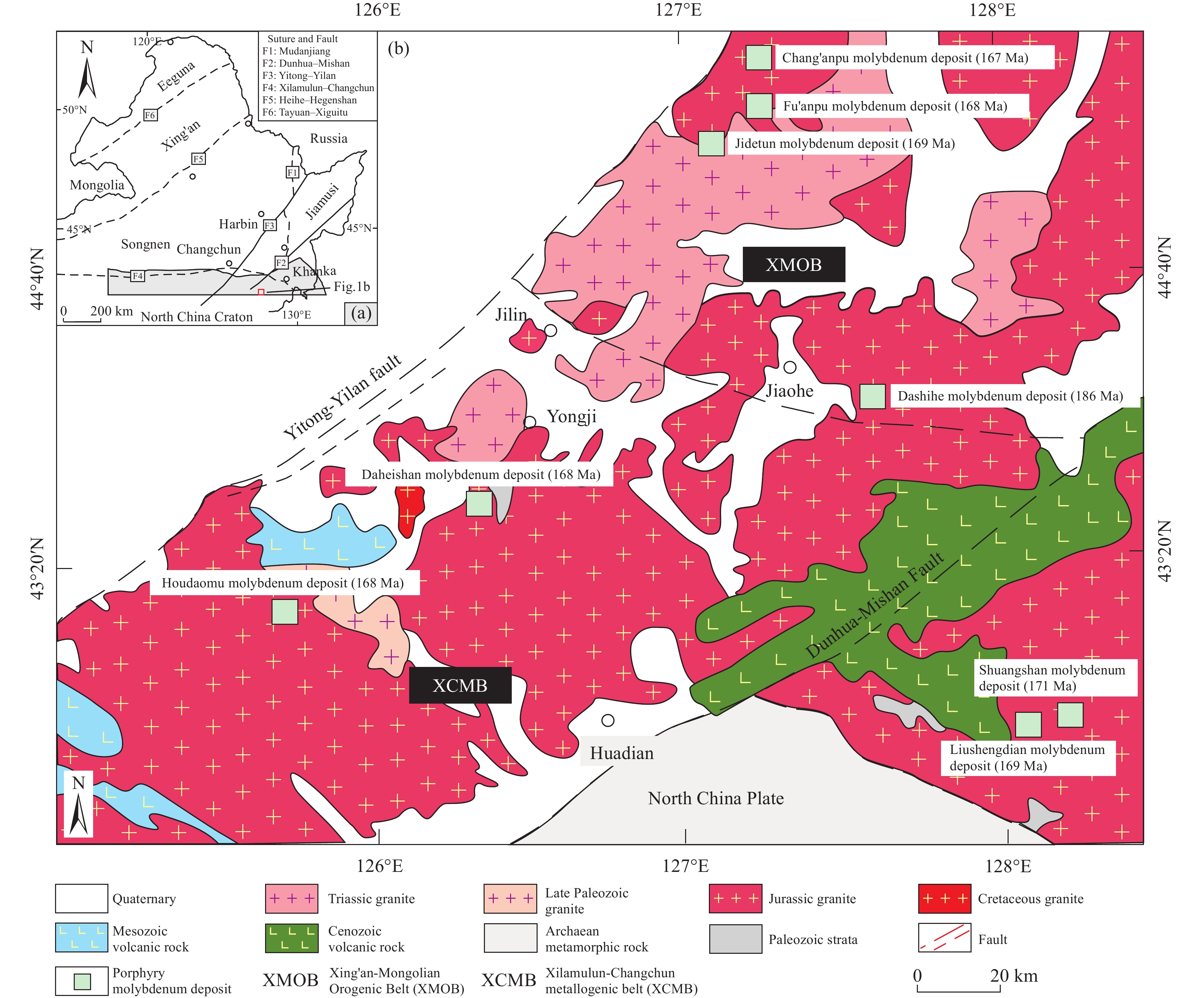

 DownLoad:
DownLoad:


